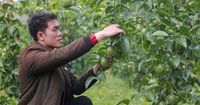On April 14, 2025, China reaffirmed its position as the largest trading partner for the Association of Southeast Asian Nations (ASEAN), accounting for 16.6% of China's total trade value. This announcement came from the Chinese Customs Administration, which reported robust trade turnover figures for the first quarter of the year. The trade turnover between ASEAN and China reached approximately $414 billion, marking a 7% increase compared to the same period last year.
China's imports of agricultural products from ASEAN saw a significant increase, with a reported value exceeding $5.2 billion. This surge included a 20% rise in the import of agricultural goods, showcasing the growing interdependence between the two regions. In tandem, ASEAN's agricultural exports to China also experienced growth, with exports rising by 13.8% and reaching a value of about $3.8 billion.
The strengthening trade ties were further highlighted on April 15, 2025, when Vietnam's Ministry of Agriculture and Rural Development announced a formal agreement with the General Administration of Chinese Customs. This agreement allows Vietnam to export passion fruit, durian, and bird's nests to China, contingent upon compliance with plant quarantine and food safety standards.
Under the new protocols, Vietnam's passion fruit, which is cultivated on over 12,000 hectares and yields around 200,000 tons annually, will be exported to China as long as it meets the stringent quality requirements set forth by Chinese authorities. Notably, Vietnam has identified its potential in agriculture as largely untapped, with many opportunities lying ahead.
The agreement also includes provisions for exporting durian and bird's nests, with an emphasis on meeting inspection and quarantine standards. As China continues to demand higher quality agricultural products, Vietnam is poised to enhance its agricultural exports significantly.
In terms of pepper exports, Vietnam's performance in 2024 was noteworthy. The country exported 10,433 tons of pepper, generating a total export value of $25.1 million. This figure represents a 2.6% increase compared to the previous year. Notably, China was the largest market for Vietnamese pepper, accounting for 75% of the total export volume, with an estimated 7,811 tons shipped to the country.
Vietnam's agricultural sector has been proactive in seeking new markets and expanding its export capabilities. The country has successfully exported its products to 22 countries, including significant markets in Europe, Australia, and the United States. With ongoing negotiations to open new markets, including the U.S. by 2028, Vietnam is focused on enhancing its agricultural product quality and expanding its export portfolio.
Both China and Vietnam are navigating a dynamic trading landscape characterized by increasing demand for quality agricultural products. As China continues to tighten its food safety regulations, Vietnam is adapting by ensuring that its agricultural exports meet these elevated standards.
The recent agreements are expected to bolster Vietnam's agricultural exports significantly, providing new opportunities for farmers and producers in the region. By focusing on quality and compliance, Vietnam aims to capitalize on the growing demand from China and other international markets.
As the two nations strengthen their trade relations, the implications for the regional economy are profound. The increased trade turnover not only benefits Vietnam and China but also enhances the economic ties within ASEAN, fostering a more integrated and collaborative regional economy.
In summary, the recent trade agreements and increasing export figures underscore the importance of agricultural trade between China and ASEAN, particularly Vietnam. As these nations continue to align their agricultural standards and trade practices, the future looks promising for both economies, paving the way for sustained growth and mutual benefit.






